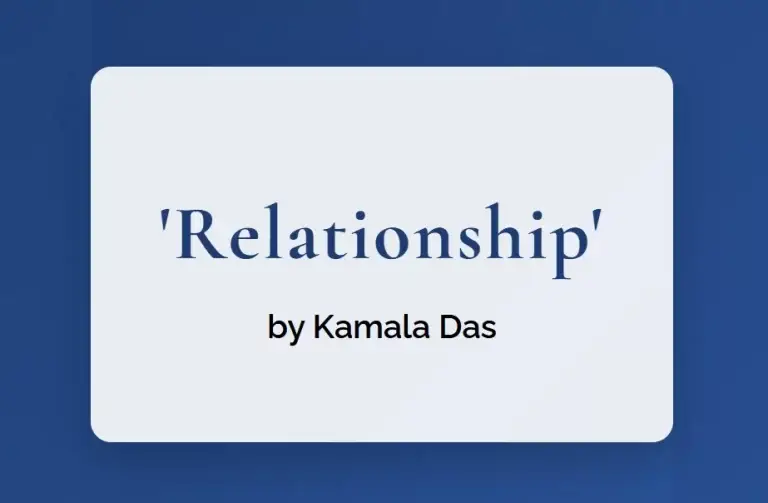The Eternal Nature of Love: Analysis of “Relationship”
Kamala Das’s “Relationship” presents a masterful exploration of love’s paradoxical nature, weaving together themes of time, creation, and emotional dependency. Through carefully crafted verses, Das examines the complex dynamics between lovers, where betrayal and necessity coexist in an intricate dance of emotional survival.
Table of Contents
The poem in full:
This love older than I by myriad
Saddened centuries was once a prayer
In his bones that made them grow in years of
Adolescence to this favored height; yes,
It was my desire that made him male
And beautiful, so that when at last we
Met, to believe that once I knew not his
Form, his quiet touch, or the blind kindness
Of his lips was hard indeed. Betray me?
Yes, he can, but never physically
Only with words that curl their limbs at
Touch of air and die with metallic sighs.
Why care I for their quick sterile sting, while
My body’s wisdom tells and tells again
That I shall find my rest, my sleep, my peace
And even death nowhere else but here in
My betrayer’s arms…
Technical Analysis: Structure and Form
Temporal Dimensions
The poem opens with a striking temporal perspective: “This love older than I by myriad / Saddened centuries.” This establishes love as an ancient force, predating the speaker’s existence, suggesting both its universality and its weighted history.
Enjambment and Flow
Das employs strategic enjambment throughout the poem, creating a flowing narrative that mirrors the continuous nature of the relationship she describes. Notable examples include:
- “years of / Adolescence”
- “we / Met”
- “here in / My betrayer’s arms”
Thematic Analysis
1. Creative Power of Desire
One of the poem’s most striking assertions appears in the lines:
It was my desire that made him male
And beautiful
This suggests the transformative power of love and desire, positioning the speaker as both creator and created, architect and inhabitant of the relationship.
2. Paradox of Betrayal
Das presents a complex understanding of betrayal through the lines:
Betray me?
Yes, he can, but never physically
Only with words that curl their limbs at
Touch of air and die with metallic sighs.
The betrayal described is purely verbal, yet the metaphor of words that “curl their limbs” and “die with metallic sighs” gives these verbal wounds a visceral, physical quality.
3. Physical Truth vs. Emotional Pain
The poem’s conclusion presents a powerful paradox:
Why care I for their quick sterile sting, while
My body’s wisdom tells and tells again
That I shall find my rest, my sleep, my peace
And even death nowhere else but here in
My betrayer’s arms…
Literary Devices and Imagery
- Personification
- Words that “curl their limbs”
- Love as a prayer in bones
- Body’s wisdom that “tells and tells again”
- Metaphor
- Words dying “with metallic sighs”
- Love as a prayer
- The body as a source of wisdom
- Paradox
- Finding peace in the betrayer’s arms
- Love that both creates and destroys
- Desire that shapes the beloved’s identity
Contemporary Relevance
Das’s exploration of emotional dependency and betrayal remains startlingly relevant to modern relationships. The poem speaks to:
- The complexity of romantic attachments
- The paradox of finding comfort in pain
- The way love shapes our perception of reality
- The distinction between physical and emotional betrayal
Critical Interpretation
“Relationship” stands as a testament to Das’s ability to capture the complexity of human relationships. The speaker’s acknowledgment of finding peace in her “betrayer’s arms” speaks to the often-contradictory nature of love and dependency. This paradox is not presented as a weakness but as a profound truth about human connection.
Legacy and Impact
This poem continues to resonate with readers because it:
- Challenges traditional narratives about love and betrayal
- Presents a nuanced view of emotional dependency
- Acknowledges the complexity of human relationships
- Speaks to universal experiences of love and hurt
Conclusion
“Relationship” remains one of Kamala Das’s most powerful explorations of love’s paradoxical nature. Through its intricate weaving of temporal dimensions, personal desire, and emotional truth, the poem presents a complex portrait of love that continues to speak to contemporary readers. Its frank acknowledgment of love’s ability to both wound and heal makes it a timeless piece of confessional poetry.
For Further Reading
Explore more analyses of Kamala Das’s powerful poetry:


